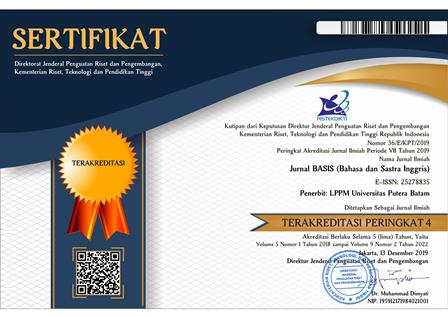THE PORTRAYAL OF PANDEMIC IN AMERICAN MOVIES
DOI:
https://doi.org/10.33884/basisupb.v8i2.3768Kata Kunci:
pandemic, American films, the concept of pandemic, the symbol of pandemicAbstrak
With the purpose of understanding the pandemic issue that is currently experienced by almost all countries, this library research examines American films with a pandemic theme to find out the reason for using this theme in films and to identify the symbol of pandemic shown in the films. By observing the dialogs and scenes in Outbreak (1995), I am Legend (2007), Carriers (2009), Contagion (2011), and The World War Z (2013), this textual analysis study utilizes the theory of representation to interpret the pandemic in the films. The results showed that the pandemic issue can be considered a promising theme because the concept of the theme includes interesting scenes such as the emergence of infectious disease, rapid virus transmission, high mortality rates, and challenges in overcoming pandemic. These scenes form a pattern – confusion, panic, emergency, survival, and treatment that can be the hallmark of a pandemic-themed film. In addition, the results of the study also suggested that films about pandemics can symbolize the reality of human’s life which is reflected through the portraits of greed, heroism, and hope.
Referensi
Adalja, A., Watson, M., Toner, E., Cicero, A., & Inglesby, T. (2018). The Characteristics of
Pandemic Pathogens. Maryland: Johns Hopkins Bloomberg School
of Public Health, Center for Health Security.
Adi, I. R. (2011). Fiksi populer: Teori & metode kajian. Yogyakarta: Penerbit Pustaka Pelajar.
Antràs, P., Redding, S. J., & Rossi-Hansberg, E. (2020). Globalization and Pandemics. National Bureau of Economic Research Working Paper Series (No. 27840).
Beach, B., Clay, K., & Saavedra, M. H. (2020). The 1918 Influenza Pandemic and Its Lesson for Covid-19. National Bureau of Economic Research Working Paper Series (No. 27673). http://www.nber.org/papers/w27673
Berger, A. A. (2010). The Object of Affection: Semiotics and Consumer Culture. New York: Palgrave Macmillan.
Buckland, W. (2003). Teach Yourself FIlm Studies. Chicago: Contemporary Books.
Cardella, E., Kugler, T., Anderson, J., & Connolly, T. (2019). “Is Greed Contagious? Four Experimental Studies.” Journal of Behavioral Decision Making, 32(5), 579–598.
Cheval, S., Mihai Adamescu, C., Georgiadis, T., Herrnegger, M., Piticar, A., & Legates, D. R. (2020). “Observed and Potential Impacts of the COVID-19 Pandemic on the Environment.” International Journal of Environmental Research and Public Health, 17(11:4140), 1–25. https://doi.org/10.3390/ijerph17114140
Creswell, J. W. (2010). Research Design Pendekatan Kualitatif, Kuantitatif, dan Mixed (3rd ed.). Yogyakarta: PT Pustaka Pelajar.
D’Souza, J. (2015). “Greed: Crises, Causes, and Solutions.” International Journal of Humanities and Social Science, 5(7), 1–6.
Franco, Z. E., Allison, S. T., Kinsella, E. L., Kohen, A., & Langdon, M. (2016). “Heroism Research: A Review of Theories, Methods, Challenges, and Trends.” Faculty Publications: Political Science, 87, 1–15.
Franco, Z. E., Blau, K., & Zimbardo, P. G. (2011). “Heroism: A Conceptual Analysis and Differentiation between Heroic Action and Altruism.” Review of General Psychology, 15(2), 99–113.
Glaser, B. G., & Strauss, A. L. (1967). The Discovery of Grounded Theory: Strategies for
Qualitative Research. New York: Aldine de Gruyter.
Gürson, P. (2011). “Fear Culture.” International Journal of Humanities and Social Science, 1(4), 208–213.
Hall, S. (1997). Representation: Cultural Representations and Signifying Practices. London: SAGE Productions.
Hariwijaya, M., & Djaelani, B. M. (2004). Teknik Menulis Skripsi & Thesis. Yogyakarta: Zenith publiser.
Hasan, M. I. (2002). Pokok-Pokok Materi Metode Penelitian dan Aplikasinya. Bogor: Ghalia Indonesia.
Hassan, K., Sadaf, S., Saeed, A., & Idrees, A. (2018). “Relationship between Hope, Optimism and Life Statisfaction among Adolescents.” International Journal of Scientific & Engineering Research, 9(10), 1452–1457.
Huen, J. M. Y., Ip, B. Y. T., Ho, S. M. Y., & Yip, P. S. F. (2015). “Hope and Hopelessness: The Role of Hope in Buffering the Impact of Hopelessness on Suicidal Ideation.” PLoS ONE, 10(6), 1–14.
Joint Advisors. (2020). Improving Pandemic Preparedness and Management. Brussel: The
European Commission by the Group of Chief Scientific Advisors (GCSA), the
European Group on Ethics in Science and New Technologies (EGE), and Peter Piot as
special advisor to European Commission President Ursula von der Leyen on the
response to the coronavirus and COVID-19.
Keczer, Z., File, B., Orosz, G., & Zimbardo, P. G. (2016). “Social Representations of Hero and Everyday Hero: A Network Study from Representative Samples.” PLoS ONE, 11(8), 1–17.
Morens, D. M., Folkers, G. K., & Fauci, A. S. (2009). “What Is a Pandemic?” The Journal of Infectious Diseases, 200(7), 1018–1021. https://doi.org/10.1086/644537
Morgan, J. (2002). Biology of Horror: Gothic Literature and Film. Illinois: Southern Illinois University Press.
Prohászková, M. V. (2012). “The Genre of Horror.” American International Journal of Contemporary Research, 2(4), 132–142.
Qiu, W., Rutherford, S., Mao, A., & Chu, C. (2016). “The Pandemic and Its Impact.” Health, Culture and Society, 9(10), 2–11.
Sklar, R. (1975). Movie-Made America: A Cultural History of American Movies. New York: Random House, Inc.
Snyder, C. R. (2002). “Hope Theory: Rainbows in the Mind.” Psychological Inquiry, 13(4), 249–275.
Štaud, O., & Obornẏ, J. (2015). “Hermeneutics of (Sport) Heroism.” Journal of Human Sport & Exercise, 10(1), 320–329.
Turner, G. (2003). Film as Social Practice. New York: Routledge.
Vries, M. F. R. K. de. (2016). “The Greed Syndrome”. INSEAD Working Paper (2016/26/EFE).
Wang, L., Malhotra, D., & Murnighan, J. K. (2012). “Economics, Education, and Greed.” Academy Management Learning & Education, 10(4).
Watson, R. (2003). Film and Television in Education: An Aesthetic Approach to the Moving Image. London: The Falmer Press.
Wehmeier, S. (2000). Oxford Advanced Learner’s Dictionary (6th ed.). Oxford: Oxford University Press.
World Health Organization. (2014). Infection Prevention and Control of Epidemic-and
Pandemic-Prone Acute Respiratory Infections in Health Care. Geneva: Author.
##submission.downloads##
Diterbitkan
Terbitan
Bagian
Lisensi

















